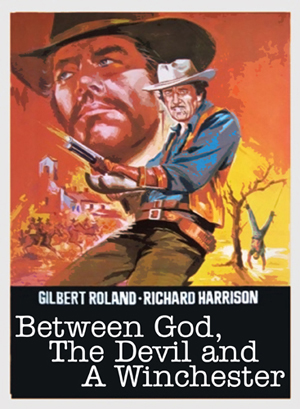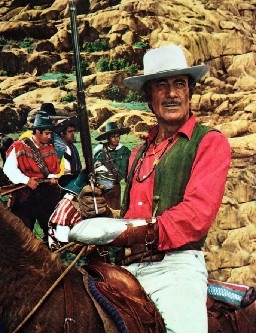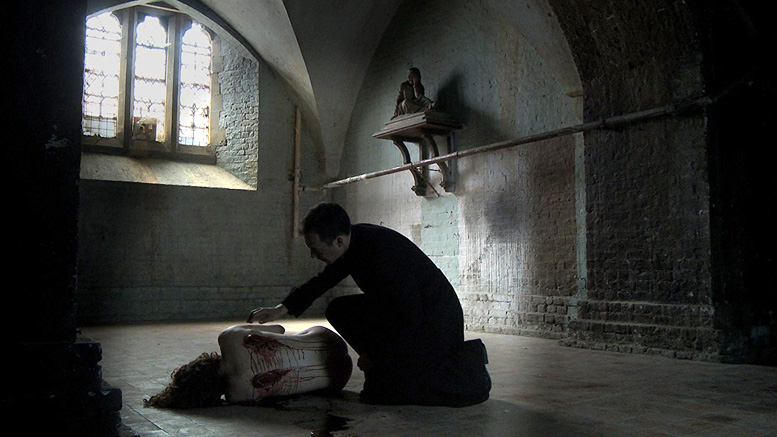
Aka Anche Nel West C’Era Una Volto Dio (Italy), Entre Dios Y El Diablo (Spain)
Italy/Spain
1968
Produced by Marino Girolami for Circus Film (Rome) and R.M (Madrid)
Director: Dario Silvestri [Marino Girolami]
Story: Liberally based on ‘Treasure Island’ by Robert Louis Stevenson
Screenplay: Marino Girolami, Amedeo Sollazzo, Tito Carpi, Manuel Martinez Remiz
Cinematography: Pablo Ripoll, Alberto Fusi {Technicolor, Techniscope}
Music: Carlo Savina
Editor: Antonio Jimeno
Art direction: Nicola Tamburro, Cruz Baletzena
Original running time: 96 minutes
Cast: Richard Harrison (Father Pat Jordan), Gilbert Roland (Juan Chasquisdo), Dominique Boschero (Marta), Folco Lulli (Colonel Bob Ford), Enio Girolami (Marco Serralbo), Roberto Camardiel (Pink), Humberto Sempere (Tommy), Raf Baldassarre (Batch), Rocco Lerro, Gonzalo Esquiros, Mirella Panfili, Jose Luis Lluch Uncredited: Luis Barboo (Zed)
Considering that Richard Harrison was one of the major stars of the Spaghetti Western, it’s pretty hard to believe how average most of the films he appeared in actually were. With the possible exception of Antonio Margheriti’s Vengeance and Leopoldo Savona’s El rojo, he cannot be said to have appeared in any particularly good – and definitely no particularly significant – genre entries. Taken in that context, Between God, the Devil and a Winchester not only has a fantastic title, but is also a pretty solid film. It does borrow heavily from it’s peers, admittedly, but is assembled in a capable and functional fashion – much as one would expect from a capable director such as Mario Girolami, whose credits span from 1949s La strada buia to L’insegnante di violoncello in 1986.
Deep Lake City is a pretty miserable place; the only people passing through are those either escaping into, or escaping out of, the desert (strangely, considering it’s arid location, it is also always raining). It’s not too strange, then, when a fat, uncommunicative fellow, Ford (Folco Lulli), turns up at the local tavern and demands a room. One of the customers, Chasquisdo (Gilbert Roland), is pointed out to him as the best scout in the area, but when asked refuses to take him to Santa Blanca (a notoriously desolate place) unless he’s paid in advance. Ford can’t do this, as he has no money; what he does have is a treasure map – but until that is transferred into gold it can’t be used to buy anything.
Unfortunately, a motley group of bandits led by Pedro Batch (Raf Baldassarre) are also after the treasure map, and it doesn’t take them too long to turn up on his trail. Whilst trying to escape from them Ford is accidentally killed, but not before passing the invaluable parchment on to Tommy (Humberto Sempere), the young nephew of the tavern-keeper. Tommy entrusts it to his saintly new friend, another stranger called Pat Jordan (Harrison), who reveals that Ford was an ex-confederate Colonel who had turned bad. After the cessation of hostilities he had stolen a chest of jewels from a mission, the hidden whereabouts of which is pinpointed by the map. When confronted with this information, Chasquisdo decides to revise his views and agrees – for a price – to guide them into the heart of the wilderness.

From the above synopsis, it’s easy to figure that this is another film with a post-war setting (see also Acquasanta Joe, Shango etc etc) which utilizes the central MacGuffin of a ‘search for a hidden treasure’. Of course, the grand-daddy of it’s type was Leone’s The Good, the Girl and the Ugly – and Girolami’s production remains entirely in that films thrall, despite even namedropping Robert Louis Stevenson’s timeless classic Treasure Island as a source. Similarly, it is much more concerned the multitudinous ways in which the disparate set of characters attempts to interact, betray and – inevitably – kill each other.
It also means that there are lots of scenes in which people wander around in glorious landscapes while nice music plays on the soundtrack, which is always a pleasure. As for the characters, Gilbert Roland’s Chasquisdo stands out. A wily old goat, he portrays himself as being ‘one of the people’, but is in fact far more intelligent than 99.9% of ‘the people’, and knows it only too well. His earthy superficialities hide a rather complex and melancholy individual. Unfortunately, his humanity is brought out Tommy the brat, who would bring most people out in hives. It’s not too far removed from Roland’s role in Enzo Castellari’s Go Kill and Come Back, another film in which he’s extremely effective. In Go Kill and Come Back, however, his main foil was played by George Hilton, who is a much more effective performer than Richard Harrison, who’s Pat Jordan remains an entirely bland concoction.
Overall, then, a slightly above average effort, which is thankfully free from the twin genre curses of bad humour and bad pacing. There’s also a hugely entertaining ‘tragic’ sequence in which the cook is shot whilst trying to save his favourite pot: “That pot was just sitting there…I’d made a real good dinner…bleurg…”
